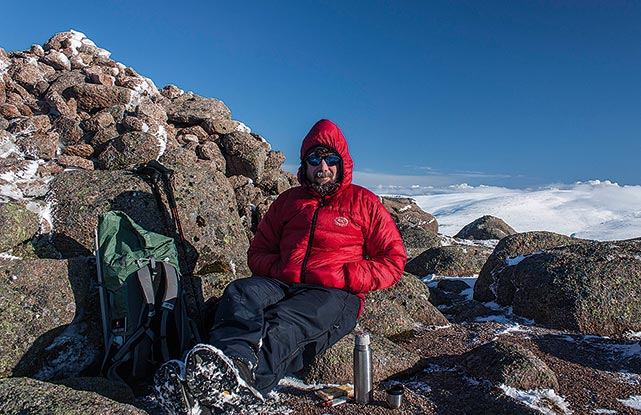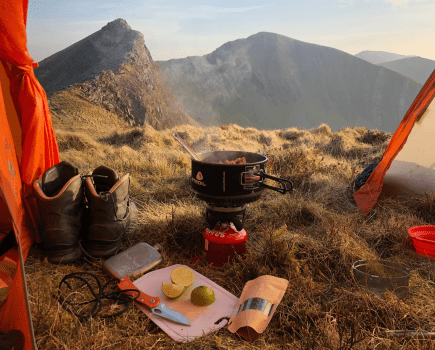Winter hiking means extra clothing, plus – if there is snow on the hills – the need to carry an ice axe and crampons. Backpackers also need a warmer sleeping bag and a tent that will stay up in snowstorms. This means a heavier pack both for day walks and overnight trips. However careful selection of equipment can keep the weight down.
It’s possible to go winter backpacking with less weight than some people carry for a summer trip. What is important is not to cut it too fine. Winter weather is unforgiving and equipment must be adequate. It’s wrong, though, to equate that with heavy gear. Consideration must also be given to where and when equipment is used.
Footwear
Trail shoes and lightweight boots are fine for winter as long as steep snow and ice isn’t involved. Waterproof socks and gaiters can be used to keep feet warm and dry in light footwear. And even when winter walking becomes more like mountaineering and more substantial boots are required, these don’t have to be very heavy.
Shelters
Summer backpacking tents are fine on sheltered sites, as long as heavy snowfall isn’t expected. For higher camps and snow, single-pole, single-skin shelters are stable and roomy and far lighter than geodesic domes, the classic design for winter mountains.
Sleeping bags
A good sleeping bag rated for winter use is essential and will weigh more than a summer one. However down-filled sleeping bags are much lighter than synthetic sleeping bags with the same warmth rating and can weigh less than a kilo. Down bags take up much less room than synthetics too, so a smaller and lighter pack can be used.
Insulated clothing
Down is also good for clothing, especially in sub-zero temperatures. A light down jacket will be much lighter than two or more fleece jackets providing similar warmth. Water-resistant down makes down clothing much more usable in Britain now. However, thin synthetic insulated clothing is warmer than fleece for the weight too – and there are now many very light garments.
Cooking
In winter hot food and drinks provide real boosts to morale. However cooking requires more fuel in winter, especially if snow has to be melted. Fuel weight can be reduced by using a pot cosy so food can continue cooking when off the stove. A heat exchanger pot also means less fuel is needed, though these weigh more than conventional pots so you need to be out for more than a few days before there’s a weight advantage. Insulating the stove and fuel container from snow or frozen ground also reduces fuel use.
Crampons
Snow and ice in the hills mean that an ice axe and crampons are essential, but you don’t necessarily need to use full-weight climbing gear. Lightweight walking crampons work well except on really steep slopes and weigh far less than mountaineering crampons. The Hillsound Trail Crampons Ultra, reviewed in this issue, weigh 426 grams while the Grivel Air Tech Lights, which are more suitable for steeper slopes, weigh 455 grams. These crampons can also be fitted to bendy boots and even trail shoes. Mountaineering crampons weigh from 700 grams upwards (the popular Grivel G10s weigh 822 grams for example) so a significant amount of weight can be saved here.
Ice axe
Lightweight ice axes designed for walking or glacier travel weigh far less than traditional axes and are perfectly adequate for hillwalking. For example the 70cm CAMP Corsa ice axe weighs just 282 grams in the 70cm length whereas the 73cm CAMP Neve weighs 584 grams, again a significant weight difference.
Photos: Chris Townsend







